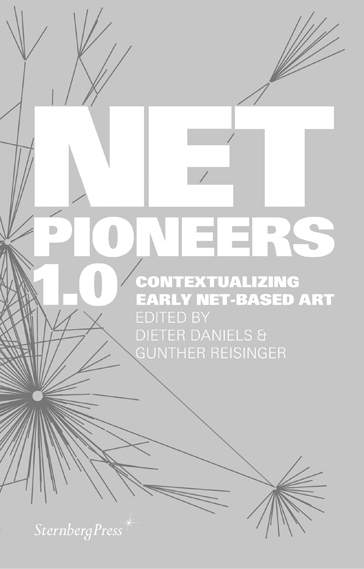Limina No. 1: Unidentified Narrative Objects – New Video Production and New Media Art (2010) [Italian/English]
Filed under journal | Tags: · internet, italy, media theory, new media, new media art, video, video art
This journal is the first of a series written by members of the Ph.D Planetary Collegium M-Node, and published by NABA Nuova Accademia di Belle Arti Milano. The series will be a collection of reflections and observations by the Ph.D researchers who are part of the programme, and by interpreters of the contemporary digital culture.
The Ph.D Planetary Collegium is an international network of research based on the rapport between art, design, philosophy, technology and science, which welcomes researchers from all over the world. It has been founded by Roy Ascott, a pioneer in telematic and cybernetics art, whose work has developed in the fields of arts, technologies and consciousness.
Questo volume inaugura una serie di testi di ricerca realizzati a cura del Programma dottorale Phd Planetary Collegium – M-Node ed editi dalla Nuova Accademia di Belle Arti di Milano. Una raccolta di riflessioni e di osservazioni realizzate dai ricercatori che partecipano al programma e da interpreti della cultura digitale contemporanea.
Editor: Francesco Monico
Scientific advisory committee: Francesco Monico, Derrick De Kerchkove , Antonio Caronia, Pier Luigi Capucci
Publisher M-Node, NABA Libri, Milan, May 2010
ISBN 978-88-95286-07-5
212 pages
PDF [Italian/English]
Comment (1)Dieter Daniels, Gunther Reisinger (eds.): Net Pioneers 1.0: Contextualizing Early Net-Based Art (2010)
Filed under book | Tags: · 1990s, art history, art theory, internet, internet art, media art, net art, network society, new media art

“Net Pioneers 1.0 discusses media art history with a new, interdisciplinary look at the historical, social, and economic dynamics of our contemporary, networked society.
The hype around Net-based art began in the early 1990s, before the Internet had become a commodity. It developed in skeptical parallel to the rise and decline of the new economy. But why does this chapter of art history appear to end so suddenly? Is it that the idea of Net-based art involving itself in a revolutionary spirit in a networked society failed? One might equally well argue that it was far too successful simply to become another media-art genre. Looking today at the social, aesthetic, and conceptual approaches of the early 1990s presented in this book, it is clear that most of them have in fact come true, if in ways other than intended.
The contributions cover a wide variety of topics, ranging from art-scholarly methodological debate (Bentkowska-Kafel, Kuni), source-critical analysis (Reisinger), archiving, exhibition, and analytical practice (Ernst, London, Paul, Sakrowski) to media-philosophical aspects (Ries) and technical and artistic innovations (Daniels).”
Contributions by Anna Bentkofska-Kafel, Dieter Daniels, Wolfgang Ernst, Verena Kuni, Barbara London, Christiane Paul, Gunther Reisinger, Marc Ries, Robert Sakrowski and Julian Stallabrass.
Publisher Sternberg Press, Berlin and New York, February 2010
Co-published with the Ludwig Boltzmann Institute Media.Art.Research
ISBN 978-1-933128-71-9
240 pages
Publisher
Co-publisher (archived)
PDF (index missing; updated on 2018-11-27)
PDFs
Agnieszka Pokrywka: Sztuka nowych mediów Europy Środkowo-Wschodniej w latach 2000-2009 (2009) [Polish]
Filed under thesis | Tags: · 2000s, east-central europe, media art, network society, new media art
“The thesis is a presentation and analysis of contemporary new media art in Central and Eastern Europe in the context of history (soviet times) and current situation (network society). First chapter of this work is focused on the issues mentioned above, simultaneously being kind of theoretical introduction to the concepts of Central and Eastern Europe, network society or new media art which are closely related to the technological revolution. Second chapter is kind of fusion between mentioned above subjects which apparently seem to be very different and discordant but in fact they’re deeply connected and dependent. Analysis of them allow us to understand correctly and truly realities of new media art origins in Central Eastern Europe. Comprehending of these terms became to be a necessary base for analysis technologically based art in the context of European (Chapter Three) and global (Chapter Four) networks of media creativity. Speaking generally, what has been discussed theoretically in the first part of this work is supplemented by specific examples in the second half which is showing different networks focused on organization, theory, practice of technological art. Complex and variable networks of new media art centers were visualized as a CEEMAC2000+ map (Appendix 3). The main aim of this thesis is to underline historical, political and economical influence on new media art development in Central Eastern Europe.”
Master of Arts thesis
Dept of Art Criticism and Promotion, Poznan Academy of Fine Arts, 2009
Supervisor: Professor Grzegorz Dziamski
Creative Commons BY-NC-ND 3.0 Poland License
111 pages


